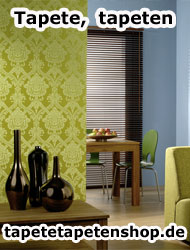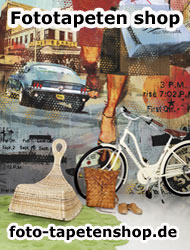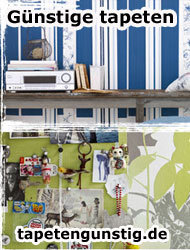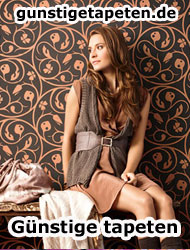

Kedves Vásárlóink!
Megújult webáruházunk nagyobb választékkal,
változatlan kedvezménnyel várja Önöket!








Dear Customer!
Prior to wallpapering:Begin by familiarising yourself with the wallpaper. Cut the lengths at the markings and lay them out in the right direction and check that the pattern matches and that there are no edge variations. If you discover a problem, stop wallpapering immediately and contact your dealer.Adhesive:Use adhesive for non-woven wallpaper.
Your needed tools:
 |
 |
 |
 |
A plumb line (e.g. a pair of scissors hanging from string) for checking that the wallpaper lengths hang straight |
Pencil |
Roller | Brush for areas where the roller cannot be used |
 |
 |
 |
 |
| Tray | Container of clean water | Soft sponge/clothNB! Do not rub the wallpaper. Instead, use more water | Papering tool |
 |
 |
||
| Steel rule/spatula (for support when trimming the wallpaper at ceiling and floor le | Wallpaper knife |
Start wallpapering:
 |
 |
| 1. Align the first length using a spirit level or plumb line (string + a pair of scissors). If you prefer, mark guidelines on the surface for more precise wallpapering. |
2. Apply sufficient adhesive to the wall to cover a width of 2-3 lengths (90-135 cm). It is important that the entire surface be covered with adhesive without leaving any bare patches, as these cause blisters beneath the wallpaper. Make sure there is a thin, even layer of adhesive over the entire surface. Use a brush for areas that are hard to reach with the roller. Be sure to check that the length adheres to the surface.
|
 |
 |
| 3. Follow the instructions at the top and bottom of the length. (Check which is up and which is down) |
4. When moving the wallpaper to the wall, fold the length together in the middle with the pattern inwards in order to avoid getting adhesive on the front of the wallpaper. |
 |
 |
| 5. Attach the top of the length to the wall at the preferred height and in the correct position before letting go of the rest. | 6. Align the top and bottom of the first length before “smoothing down” the wallpaper. Never try to reposition a length of wallpaper. If you make a mistake, remove the length and start over. Apply more adhesive if the first coat has dried. |
 |
 |
| 7. Use the papering tool to smooth out the wallpaper and remove any excess adhesive and air bubbles. Keep the papering tool clean! Always wipe the papering tool clean to remove any adhesive residue or ink transfer. Using the papering tool, work from the ceiling to the floor and from the middle to the edges. | 8. Then continue with the next length, matching up the edges. Ensure that the lengths are properly positioned and that there is no surface visible at the joints. It is important that adhesive be applied right out to the edges to ensure the lengths adhere to the wall properly. |
 |
 |
| 8. Cut away anything that is not actually wallpaper (instructions, white edges). Preferably use a steel rule or spatula for support when trimming the wallpaper. Replace the blade often, as a dull blade can easily tear the wallpaper. | 10. Continue in this manner until the wall is finished. |
Questions & Answers:
Wipe away adhesive!
If you get adhesive on the front of the wallpaper, wipe it off immediately with a damp sponge. Do not rub at the wallpaper; instead, use more water. If the sponge is dry, it can act as an abrasive.
The wallpaper is patchy!
Newly-hung wallpaper may appear blistered and spotted, but this should disappear after 24 hours or so.
Air the room!
Remember never to shut up a room of newly-hung wallpaper, but leave to air and maintain a normal room temperature to ensure the wallpaper dries properly. The room and wall should be kept at a minimum of +18 °C.
Raised edges, blistering and gaps?
These common problems are not due to the wallpaper, but rather to the amount of adhesive used, the surface and the method of wallpapering. Damaged materials are replaced with a defect-free version on production of an order. Mr Perswall is not responsible for painting and rewallpapering costs or costs associated with loss of time or any other indirect damage.
Wallpapering over plasterboard or chipboard?
Apply a preliminary layer of adhesive or undercoat to very absorbent surfaces. Otherwise, the surface will absorb water from the adhesive.
Wallpapering over woven glass or other painted fabrics?
Must be filled and sanded. Apply a preliminary layer of adhesive.
A contrasting background!
Use an undercoat if there is a noticeable difference in colour to the surface, such as filled joints in a dark surface or wallpaper with a bold pattern.
Even and smooth surface!
Remove the surface layer of seagrass, vinyl, textile or structured wallpapers before rewallpapering.
Wallpapering over a painted surface?
The surface should be washed with a degreasing agent or similar and rinsed with water, particularly if gloss paint has been used.
Product support information:
Hajlék-2000 Kft
College to contact: Ilona Nagy Mészarosné
Tel.: +36 30 9 798 234
Mobile: +36 30 9 798 234
E-mail:
This email address is being protected from spam bots, you need Javascript enabled to view it
www.tapetawebaruhaz.hu.